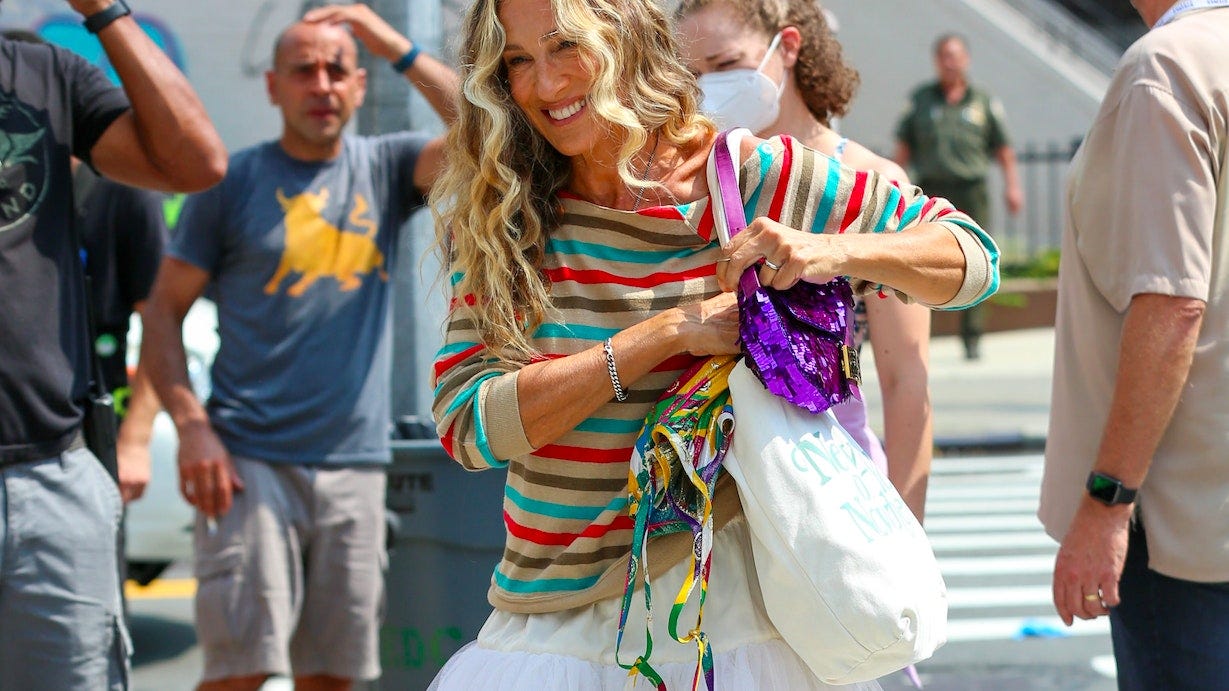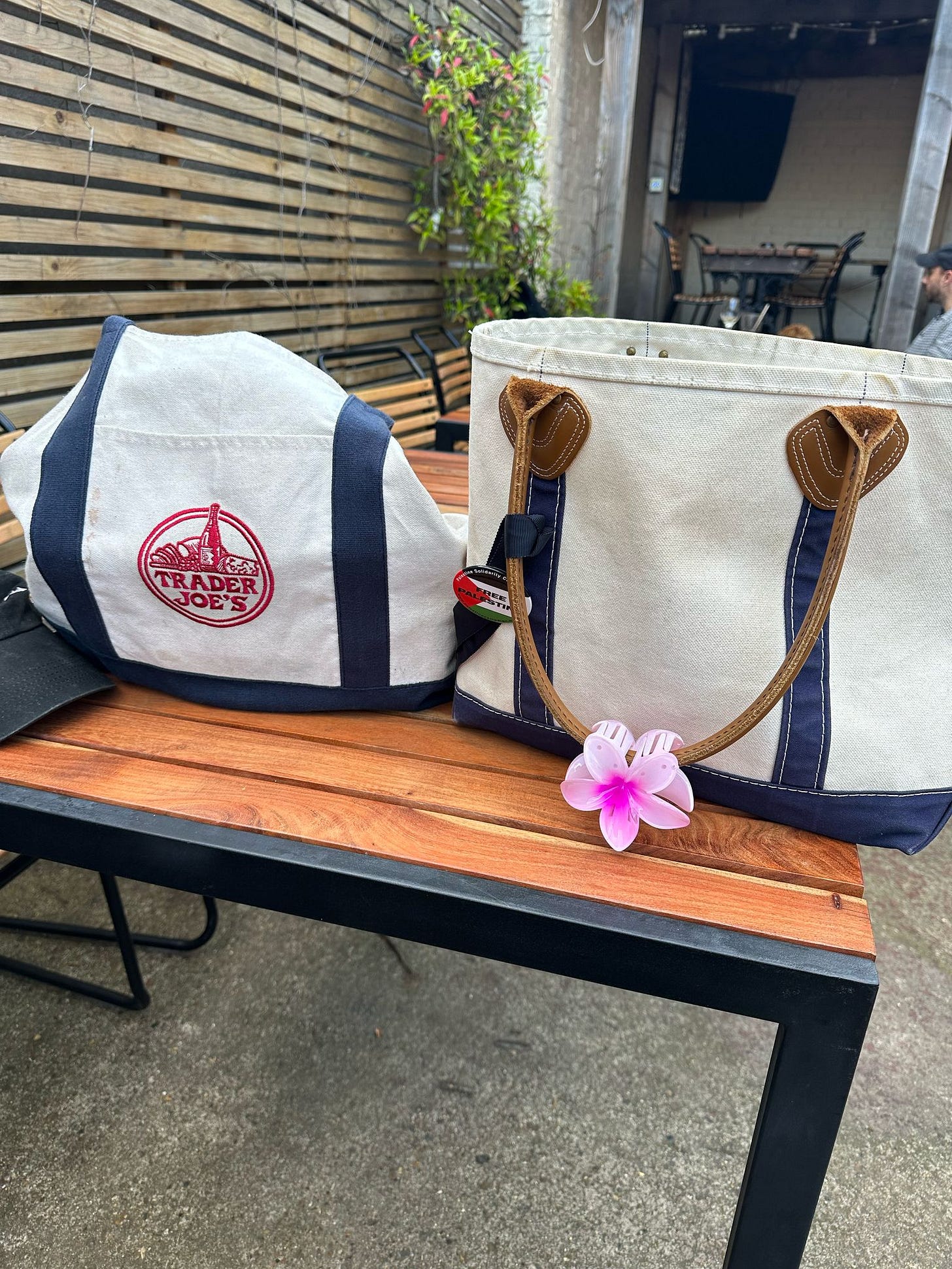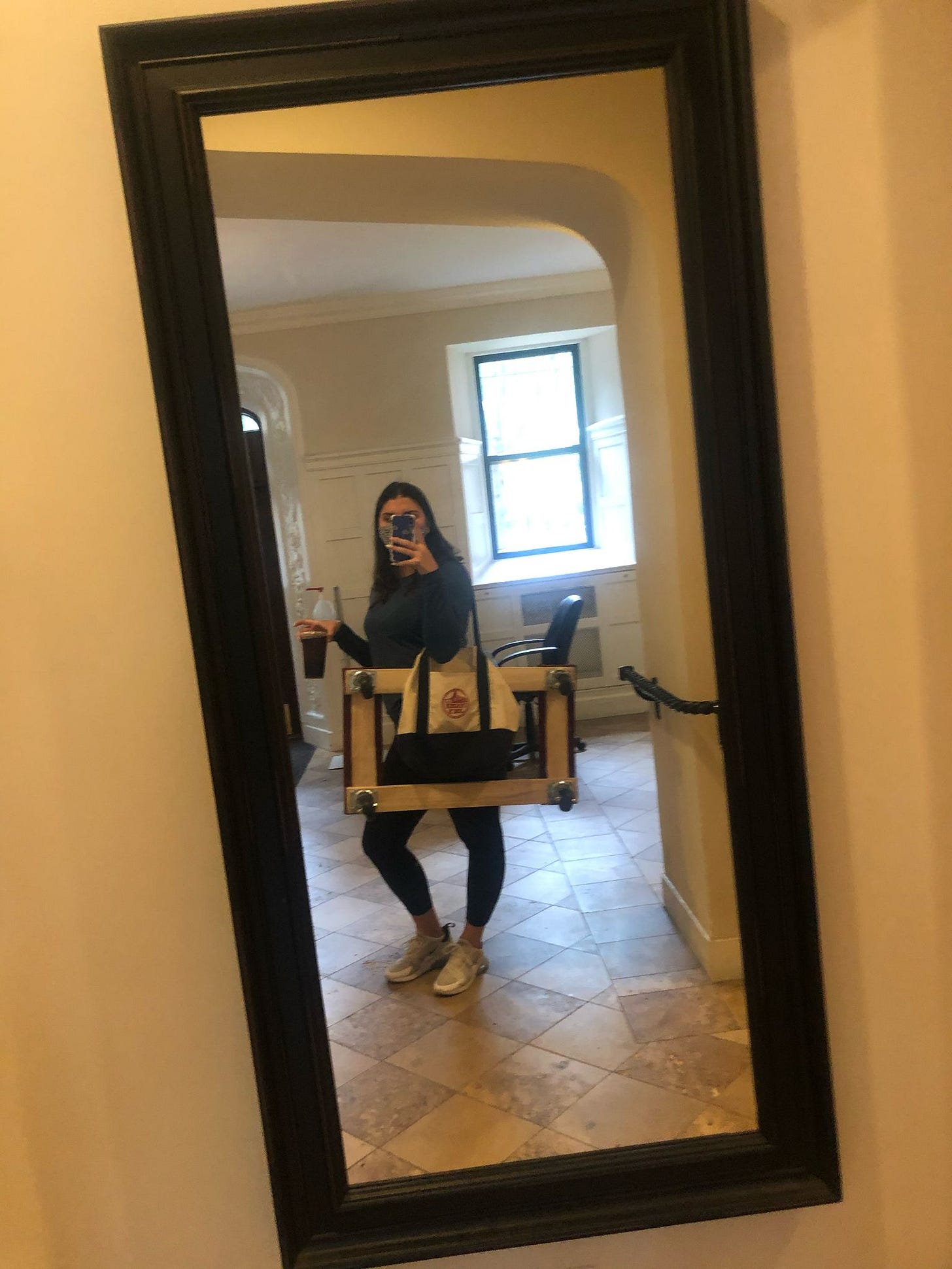Welcome back to Chic! a newsletter by Rebecca Thimmesch. Have you subscribed?
I sat en terrasse the other morning outside Devotion Coffee with a friend. Devotion was mentioned in perhaps the earliest viral Topjaw video with Joe Jonas--you can still find screenshots of the Reel taped up under the counter a year later, battery percentage uncropped. It’s a nice local place, although I can get a filter coffee for a pound cheaper elsewhere nearby and with celebrity sightings much more to my taste. Anyways, I was sitting in the cold, sunny morning light and catching up with my friend. Our hour long conversation spanned the banal and the weighty as these things often do, and I was very trained on my friend and what she was telling me, but I couldn’t help but notice that six Trader Joe’s tote bags--the “viral” canvas ones with the navy straps--passed through my field of vision.
A tote every ten minutes! And not in Soho or on Brick Lane where all the 19 year olds dress alike, but next to the library and the fishmonger. And not just on Tik Tok-addled young people, but on elderly women and uncles and other busy, average people.
To quote John Waters, “yeah, it is a phenomenon. Another phenomenon.” This particular phenomenon has been brewing for some time. Three summers ago, a girl stopped me on the street as I lugged my groceries towards home. “Where’d you get that bag?” she asked, catching me off-guard. “Trader Joe’s?” I replied. Her face fell. “Oh, you’re American. I’ve been looking for one of those but they’re so expensive on Depop.” It was one of those interactions where I had to be like, sure, and keep it moving, but it was a watershed. I went home and looked on Depop, they were selling for up to 40 pounds! Suddenly, the bags were everywhere. They dotted the grass of London Fields and Victoria Park, they sat between tired feet on the train in the mornings, I even saw a few in bars. And while these tote bags were the same as the ones I kept balled up in my entryway, they didn’t look like it. These were pristine, still off-white, almost starched looking bags. They weren’t carrying a bunch of reusable produce bags, a few errant shallot skins, and a stack of grocery store loyalty cards. They were carrying laptops!
courtesy of @real_housewives_of_Clapton on Instagram
This wasn’t just a London thing. In the past few years, the Trader Joe’s bag has gone from random quotidian thing to viral, Tik Tok romanticized Thing pretty much everywhere. Trader Joe’s released a miniature version of the canvas tote to complete mayhem, with reports of a set of four sold on eBay for $500!
How Trader Joe’s tote bags became an unexpected style symbol in Japan
It’s perhaps the latest in a very long line of it-totes.
The it-bag gets a lot of press. Dior saddle bags and Loewe puzzle bags and of course Birkins and countless others. Whatever the bag, it says the same thing: I have money, I’m fabulous. The it-tote, however, conveys something more complex.
One’s choice of tote bag is less about the obvious signals of wealth or power and more about other, more discrete forms of cultural cache. Lots of it-totes are literary: Daunt Books, Shakespeare and Co, The Strand, and various independent bookshops. I never had the New Yorker tote, much to my chagrin. It’s very important to signal that one reads.
London in particular is rife with eyeglasses brand totes, which I suppose imply bookish intelligence the same way eyeglasses themselves do.
And there’s the ideological tote. RBG’s collar, pussy grabs back, boot edge-edge. You get the gist. There are plain totes, like the L.L. Bean Boat and Tote, which are ideological in their apparent lack thereof. Old money, etc.
But what does the Trader Joe’s tote signal?
I asked some British people about why they loved their Trader Joe’s bags if they had them, and why they wanted one if they didn’t.
Everyone was effusive about the structure of the bag itself. The canvas tote is, if nothing else, a great tote bag, and its construction reveals the flaws of so many others. First of all, it’s in landscape. Why, why are so many tote bags in portrait?? Have their creators not yet heard about gravity?? It’s ridiculous, and I have no room in my life for any bags still daring to be vertical when I have such excellent horizontal options at my disposal. The tote is made of a heavy-duty cotton/polyester canvas material, it’s constructed in 3D with deep corners (flat totes, also not worth your time), and its straps come up from the bottom and are stitched into the entire rise of the bag, making them very strong. Critically, it has two pockets.
Sturdy, great straps, and pockets. A good color scheme that many described as reminiscent of L.L. Bean, at a fraction of the cost. Everyone I spoke to agreed, it’s a great bag, it’s affordable, and if you can get your hands on one, why wouldn’t you?
But, I ask, what does it signal?
A few people I spoke with went further. As a Brit, walking around with a Trader Joe’s bag also implied that they had the means to travel to the US, that perhaps they had just come back from New York or LA where they’d been leisurely shopping for Scandinavian Swimmers. It implied a worldliness; one can’t just travel these days via hotels and tour groups, one has to immerse.
Tourism has always been a problematic industry. It’s easy to identify the excesses of ultra-wealthy tourists parachuting into remote communities on colonialistic expeditions, or of rich pricks menacing local staff on luxury resorts. We’re on season 3 of The White Lotus, after all. Airbnb-style immersive “authentic” tourism was framed as a course correction on these excesses, but what issues have sprung up in turn?
It’s well established at this point that short-term vacation rentals, like Airbnb, contribute to housing shortages because even if you believe them that the intention behind short-term lets is for locals to monetize their own vacations and spare rooms, providing visitors with an authentic stay in return, demand for such a product was always going to outpace natural supply, and so we now have a global problem of landlords keeping units vacant as perpetual Airbnb properties because they can make more money than renting them out. And this drive for local-oriented tourism is flooding new communities with moneyed visitors taking advantage of lower costs of living, which in turn drives up costs for locals. There’s more examples than I could possibly say: Mexico City, Lisbon, Jackson Hole, Hawaii, Bali.
In the week following Bad Bunny’s announcement that he would be doing a summer residency in Puerto Rico for his album Debí Tirar Más Fotos, social media was flooded with non-residents asking where the “local, small business Airbnbs” were for them to patronize. Go ahead and run some of those songs through Google Translate, queens!
Tourism to the mainland United States, especially to major cities, doesn’t necessarily have the same connotations as elsewhere, but the preference for a more local-style travel persists.
Have you guys seen this group of Welsh people vlogging their way through New York? It kind of has everything: really interesting insight into what other people think America is, genuine joy and wonderment through cultural exchange, and me getting to explain a regional British accent to my friends.
The Welsh vloggers are, however sweet, doing types of consumption I wouldn’t typically do, and highlighting products with which I was not previously familiar. And I kinda feel the same way whenever I speak to a British person who has just returned from my home country, where they made a beeline for something really random (to me) like a $2.99 grocery bag or candy I’ve never seen or things on the Wawa menu I didn’t think anyone ordered.
For better or for worse (it’s worse), America is still the global cultural it-girl. And almost everyone everywhere has a vision in their mind’s eye of what they think America is, however warped by film and TV and music and social media.
It’s been a very interesting time to act as an unwilling emissary of the American Experiment abroad. The United States is a mythical figure worldwide, but it’s a perfect hyperfixation for the United Kingdom, which straddles a liminal space between America and Europe. On so many things—healthcare, infrastructure, vacation days—the UK leads one and trails the other. As such, America becomes the perfect boogeyman. Sometimes for good, after all what better way to caution voters against things like NHS privatization than by pointing at the world-renowned catastrophe that is American healthcare? But often it’s a cudgel, a way to avoid hard truths. Sure, there may be a problem with anti-immigrant rhetoric, or racism, or police violence or what have you, but it’s not as bad as in America!
The boogeyman/cudgel complex is on prime display as the UK navigates its exit from the European Union. The key phrase has been “chlorinated chicken,” an inflammatory-yet-apt descriptor of factory farmed poultry sold in the US, emblematic of all the horrifying American agricultural practices which loomed over the post-Brexit British food system. But just as it scares, it also protects. It paints a picture of a foreign food system so vile, so distasteful, that one needn’t interrogate their own consumption of factory farmed meat, troll-caught fish, or produce of unclear origin. Right?
So the Trader Joe’s tote has become a bit of a bee in my bonnet because the Venn diagram of people who want to talk my ear off at a party about how Americans are these dumb, unhealthy yokels sucking down XL insulated tumblers of corn syrup every day and the people rocking up to the pub with merch from my grocery store slung over their shoulder is, you know, intersecting!
But the thing is, those two circles might cross, but they don’t eclipse each other. Like those Welsh vloggers, most people are just curious and want to have a good time. They might have misconceptions, but who doesn’t? And lots of them want to go to American grocery stores because American grocery stores look fun!
I love the grocery store. You can’t really imagine how much.
On my last trip to the United States, I went to soooo many. I made my first (and second, and third) trip to Lotte Mart, a South Korean chain which has several locations across the DC Metro area, marvelling at the breadth of produce and international goods. My friend brought me into Garden of Eden in New York on a freezing, miserable day, which transported me into some sort of gorgeous 90s commercial. Phoenix of course has AJ’s, the best grocery store of all time, as well as all the ranch markets where one can buy 48 tortillas Sonorenses before flying back to London. I went to Trader Joe’s to buy two of the canvas tote bags for my friends, a few jars of Calabrian chili (it’s a great price and my hunch is that it’s private label Tutto Calabria), and some dark chocolate peanut butter cups.
Trader Joe’s is already a perennial topic of discussion. Is it an actual grocery store? Is it actually cheap? Is it a place for adult children to buy adult lunchables?
Many things can be true at once.
Trader Joe’s is, above all, a good place to buy wine, especially if you’re 19 years old. I probably spent three quarters of my undergraduate pregames drinking $4.49 bottles of vinho verde, a classy alternative to two-buck chuck (which I’m sure with inflation must cost four or even five dollars now!). And lending a touch of Portuguese elegance to the fêtes of Sigma Alpha Epsilon? Well that was my pleasure.
It’s also a place with a pretty good cheese selection, often bad produce, decent oat milks, some excellent tinned/jarred items, a frozen section not really meant to be the bulk of your diet, surprisingly good beauty products, and fabulous seasonal candles.
Like many businesses, it’s also a little, uh, problematic. In addition to your bog-standard union busting, it has been a key player in the dismantling of the National Labor Relations Board. Uh oh!
But, while it’s not actually a national brand, Trader Joe’s is perhaps the closest Americans have to a national phenomenon. I can understand why visitors would want to see it for themselves and take a little piece of it home with them. If that piece is a workhorse tote with vaguely Carolyn Bessette-Kennedy sensibilities, all the better!
I have my own complicated relationship to Trader Joe’s, but my relationship to these tote bags is very simple. I love them. My two canvas totes have been with me through a lot over the last decade.
On a crazy night in June of 2020, I ran home, grabbed one, and filled it with the scant protein bars on hand in my pantry. Running back two blocks, I passed the bars through the mail slot of a rowhouse sheltering an unnamed number of protestors. That’s right, the viral tote was at the Swann Street Kettle. There’s a reason that hundreds of people on Instagram live coverage were commenting “that girl is definitely a Fed.”
They’ve supported me through several moves, countless ill-advised hauling trips, and of course my near-constant trips to the grocery store. They live under my kitchen island, full of produce bags and other grocery detritus. I have a very strong mental block around putting my laptop in one of them but that’s for me to deal with, not you. They carry happy memories, sad ones, and sometimes wild ones. I’ll use them until they give out, which I can’t imagine will be soon. 🫒









Funny… this explains why I see tourists stock up on random stuff there sometimes. I have two insulated Monoprix bags I use here and am very fond of. Not high end to say the least. I shop there in Paris because it’s convenient and cheaper than eating out. Maybe I’m part of this phenomenon (in reverse?) without being aware. But I have never seen a French grocery bag…on the East Coast at least.
Because of the weird and often large proportions of his clothes Rick Owens has made bigger and bigger tote bags to the point that the biggest ones can hold a small adult. 😆 They were a fashion accessory at some point and they are nice canvas... but they are portrait! And they slip off your shoulder like crazy.